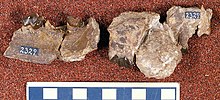Palaeonictinae
Palaeonictinae (Палаеониктинае — „древне куне”) је изумрла потпородица плаценталних сисара из изумрле породице Oxyaenidae, која је у периоду од касног палеоцена до раног еоцена настањивала подручје Европе и Сјеверне Америке.[7][8][9] Ову породицу сисара су чинили родови Ambloctonus и Palaeonictis, и парафилетски род Dipsalodon. Стручни назив за чланове ове потпородице сисара је палаеониктини.
| Palaeonictinae | |
|---|---|

| |
| реконструкција изгледа врсте Palaeonictis occidentalis | |

| |
| дјелови доње вилице врсте Ambloctonus sinosus | |
| Научна класификација | |
| Домен: | Eukaryota |
| Царство: | Animalia |
| Тип: | Chordata |
| Класа: | Mammalia |
| Кладус: | Pan-Carnivora |
| Ред: | †Oxyaenodonta |
| Породица: | †Oxyaenidae |
| Потпородица: | †Palaeonictinae Denison, 1938[1] |
| Типски род | |
| †Palaeonictis de Blainville, 1842
| |
| Родови | |
| |
| Синоними | |
Етимологија назива
уреди| Потпородица: | Поријекло назива од: | Значење назива: |
|---|---|---|
| Palaeonictinae |
|
древне куне |
Опис
уредиОве врсте сисара су имале издужено тијело са кратким ногама, масивне лобање (у поређењу са тјелом) са кратким њушкама и снажним вилицама. По својој грађи тјела су наликовали на јазавца и ждеравца. Ове врсте су се кретале плантиградно. Код представника потпородице Palaeonictinae зуби су робусни и тупо зашиљени, преткутњаци су широки а други пар горњи кутњака (M2) је мањи од првог пара (M1).[10][11] Зуби су више били прилагођени дробљењу костију него резању меса и тетива.
Систематика
уредиКласификација
уредиКласификација потпородице Palaeonictinae:
| Род: | Врсте: |
|---|---|
| †Ambloctonus (Cope, 1875) |
|
| †Dipsalodon (парафилетски род) (Jepsen, 1930) |
|
| †Palaeonictis (de Blainville, 1842) |
|
Филогенија
уредиДоље приказан кладограм представља филогенетске везе потпородице Palaeonictinae.[7][9][11][12][13][14]
| Pan-Carnivora |
|
†Altacreodus/Tinerhodon група | |||||||||||||||||||||||||||||||||||||||||||||||||||||||||||||||||||||||||||||||||||||||||||||||||||||||||
Временска распрострањеност родова из потпородице Palaeonictinae унутар породице Oxyaenidae
уреди
Види још
уредиРеференце
уреди- ^ R. H. Denison (1938) "The broad-skulled Pseudocreodi." Архивирано на сајту Wayback Machine (14. фебруар 2022) Annals of the New York Academy of Sciences 37:163-256
- ^ Floréal Solé; Bernard Marandat; Fabrice Lihoreau (2020). „The hyaenodonts (Mammalia) from the French locality of Aumelas (Hérault), with possible new representatives from the late Ypresian”. Geodiversitas. 42 (13): 185—214. doi:10.5252/geodiversitas2020v42a13.
- ^ E. D. Cope (1877) "Report upon the extinct Vertebrata obtained in New Mexico by parties of the expedition of 1874." Report upon United States Geographical Surveys West of the One Hundredth Meridian, in charge of First Lieut. G.M. Wheeler, Corps of Engineers, U.S. Army, Vol. IV Paleontology, Part II, pp. 1-365. Government Printing Office, Washington, D.C.
- ^ Gregory, W. K. and Hellman, H. (1939) "On the evolution and major classification of the civets (Viverridae) and allied fossil and recent Carnivora; a phylogenetic study of the skull and dentition." Proceedings of the American Philosophical Society, 81, 309–92
- ^ Haeckel, Ernst (1895). Systematische Phylogenie: Wirbelthiere (на језику: немачки). T.3. Berlin: G. Reimer.
- ^ Osborn, H. F. (1892) "Taxonomy and morphology of the primates, creodonts, and ungulates." In: "Fossil mammals of the Wahsatch and Wind River beds. Collection of 1891." (H. F. Osborn and J. L. Wortman), Bull. Amer. Mus. Nat. Hist., 4: 81-147
- ^ а б Gunnel, Gregg F.; Gingerich, Philip D. (30. 9. 1991). „Systematics and evolution of late Paleocene and early Eocene Oxyaenidae (Mammalia, Creodonta) in the Clarks Fork Basin, Wyoming” (PDF). Contributions From the Museum of Paleontology. The University of Michigan. 28 (7): 141—180. Приступљено 3. 1. 2010.
- ^ McKenna, Malcolm C.; Bell, Susan K. (1997). Classification of Mammals Above the Species Level. New York: Columbia University Press. ISBN 978-0-231-11012-9. Приступљено 16. 3. 2015.
- ^ а б Stephen G. B. Chester; Jonathan I. Bloch; Ross Secord; Doug M. Boyer (2010). „A new small bodied species of Palaeonictis (Creodonta, Oxyaenidae) from the Paleocene-Eocene thermal maximum”. Journal of Mammalian Evolution. 17 (4): 227—243. doi:10.1007/s10914-010-9141-y.
- ^ G. F. Gunnell (1998) "Creodonta". In C. M. Janis, K. M. Scott, and L. L. Jacobs (eds.), "Evolution of Tertiary Mammals of North America, Volume 1: Terrestrial Carnivores, Ungulates, and Ungulate like Mammals", Cambridge University Press, 703 pages ISBN 9780521355193
- ^ а б F. Solé, E. Gheerbrant and M. Godinot (2011) "New data on the Oxyaenidae from the Early Eocene of Europe; biostratigraphic, paleobiogeographic and paleoecologic implications." Palaeontologia Electronica 14(2):13A:1-41
- ^ Solé, F. & Ladevèze, S. (2017) "Evolution of the hypercarnivorous dentition in mammals (Metatheria, Eutheria) and its bearing on the development of tribosphenic molars." Evolution & Development, 19(2), 56–68.
- ^ Prevosti, F. J. & Forasiepi, A. M. (2018) "Introduction. Evolution of South American Mammalian Predators During the Cenozoic: Paleobiogeographic and Paleoenvironmental Contingencies", Springer Geology. Springer, Cham.
- ^ Shawn P. Zack (2019). „A skeleton of a Uintan machaeroidine 'creodont' and the phylogeny of carnivorous eutherian mammals”. Journal of Systematic Palaeontology. 17 (8): 653—689. doi:10.1080/14772019.2018.1466374.
Литература
уреди- E. D. Cope (1880) "On the genera of the Creodonta." Proceedings of the American Philosophical Society 19:76-82
- O. P. Hay (1902) "Bibliography and Catalogue of the Fossil Vertebrata of North America." Bulletin of the United States Geological Survey 179:1-868
- L. Van Valen (1967) "New Paleocene insectivores and insectivore classification." Bulletin of the American Museum of Natural History 135(5):217-284